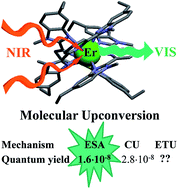Publications
-
Deciphering and quantifying linear light upconversion in molecular erbium complexes
Bahman Golesorkhi, Alexandre Fürstenberg, Homayoun Nozary, and Claude Piguet
Chem. Sci. 2019, 10(28), 6876-6885
 |
Single-center light upconversion corresponds to the piling up of low-energy photons via successive linear absorptions: a phenomenon commonly observed in lanthanide-doped low-phonon ionic solids or nanoparticles. Its ultimate miniaturization in molecular complexes opens challenging perspectives in terms of improved reproducibility, chemical control and optical programming. However, high-energy vibrations inherent in coordination complexes severely limit the efficiency of successive excited-state absorptions (ESAs) responsible for the gain in photon energy. By carefully wrapping three polyaromatic ligand strands around trivalent erbium, we managed to induce low-power room temperature near-infrared (λexc = 801 nm or 966 nm) to visible green (λem = 522 nm and 545 nm) light upconversion within mononuclear coordination complexes [Er(Lk)3]3+ operating either in the solid state or in non-deuterated solution. The calculated upconversion quantum yields set the zero-level of an elemental erbium-centered molecular ESA mechanism, a value which favorably compares with cooperative upconversion (CU) previously implemented in sophisticated multisite Yb2Tb supramolecular assemblies. The various dependences of the upconverted emission on the incident excitation power imply different mechanisms, which can be tuned by molecular design.
DOI: 10.1039/c9sc02068c
Archive ouverte / Open archive: unige:121588
